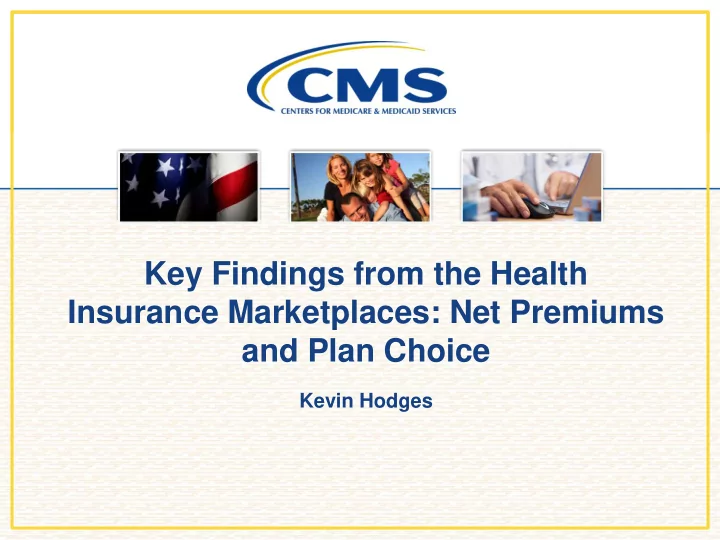

Key Findings from the Health Insurance Marketplaces: Net Premiums and Plan Choice Kevin Hodges INFORMATION NOT RELEASABLE TO THE PUBLIC UNLESS AUTHORIZED BY LAW: This information has not been publicly disclosed and may be privileged and confidential. It is for internal government use only and must not be disseminated, distributed, or copied to persons not authorized to receive the information. Unauthorized disclosure may result in prosecution to the full extent of the law.
Premium vs. Net Premium ● Marketplace premium is based on: Age Where you live Plan you choose Tobacco Use ● Net Premium = Premium minus Subsidy (Advanced Premium Tax Credit) ● Subsidy is based on: Household Income (% of FPL guideline) Cost of Second Lowest Cost Silver Plan (Benchmark) 2
Impact of Age on Premium ● Default age curve is used in most states Under 21: 0.635 * Premium for 21-year-old 64 and older: 3.0 * Premium for 21-year-old 21-24 year old: 1.0 * Premium for 21-year-old ● For Example – if a 21-year- old’s premium is $100, a 64 -year- old’s premium will be $300 (same rating area, tobacco status and plan) 3
Impact of Where You Live / Plan You Choose on Premium Silver premiums for a 21-year old by county Silver Plan Rank Carson City, Nevada Curry, New Mexico Lowest Cost $269 $195 Benchmark $284 $197 Third-Lowest Cost $296 $218 Fourth-Lowest Cost $298 $226 Fifth-Lowest Cost $302 $228 … Highest Cost $341 $271 Source: 2016 QHP Landscape File 4
Who is getting subsidies? ● Consumers who fall between 100% and 400% of FPL, don’t have ● 85% of Healthcare.gov consumers in 2016 are receiving subsidies - access to other coverage, and choose non-catastrophic plans are Advanced Premium Tax Credits (APTC) eligible to receive subsidies. FPL % for Consumers Receiving APTC: 200% FPL 400 7% 1-person household: $24K 300 7% 4-person household: $49K 250 15% 200 Receive No 24% APTC, APTC, 85% 150 15% 14% 133 150% FPL 33% 1-person household: $18K 4-person household: $36K 5
Impact of Income on Net Premium Monthly Expected Contribution, by Household Income, for 2016 (single-person tax household) $11,770 x 400% = $47,080 $47,080 x 9.66% = $4,548 $4,548/12 = $379 $11,770 x 200% = $23,540 $11,770 x 100% = $11,770 $23,540 x 6.41% = $1,509 $11,770 x 2.03% = $239 $1,509/12 = $126 $239/12 = $20 70% of those receiving subsidies are at or below 200% FPL 6
Example: Benchmark Premium vs Net Premium for Consumers at Same Income Level • Two 21 year-old non-smokers live in Carson City, NM and Curry, NV. • Both consumers are in single person tax households, and make around $17,600 a year. • Both choose the benchmark plan – the second-lowest cost Silver plan available to each consumer. 7
Example: Benchmark Premium vs Net Premium for Consumers at Same Income Level • Both consumers are in single person tax households, and make around $17,600 a year. • 100% FPL in 2016 = $11,770. • $17,600/$11,770 = 1.5, or 150% of FPL. • At 150% FPL, the expected annual contribution is 4.07%. • 4.07% x $17,600 = $716/year or ~$60/month. 8
Example: Benchmark Premium vs Net Premium for Consumers at Same Income Level • The Advanced Premium Tax Credit (APTC) – the subsidy - is the difference between the cost of the second-lowest cost Silver plan and the expected contribution. • Even for a 64-year old consumer in Carson City, at the same income, the consumer contribution – or net premium – will remain the same in the benchmark. 9
Example: Benchmark Premium vs Net Premium for Consumers at Same Income Level • For a 64 year-old: Premium = $284 * 3.0 = $852. • The subsidy is adjusted to $792 so that the older consumer, in an area with higher premiums, is still paying $60 per month. • The consumers can use this subsidy toward plans other than the benchmark. • If they choose a plan less than the benchmark, the net premium will decrease. • If they choose a plan greater than the benchmark, the net premium will increase. 10
Benchmark and Lowest-Cost Silver Plan Selections 11
Sample Rate Changes to Benchmark, 2015-2016 ● On average, benchmark increased by 7.5% from 2015 to 2016. The actual change varied by location. For example, in: Palm Beach, FL – benchmark rate went down 0.1% Travis, TX – benchmark rate went up 10% Gallatin, MT – benchmark rate went up 37% ● For someone who chooses the benchmark in 2015 and 2016 net premiums won’t change much, all else held equal. In fact, if their income remains exactly the same, their net premium can go down slightly. ● How do benchmark changes impact the most popular plan – the lowest-cost Silver? 12
Changes in Benchmark Impact Net Premiums for All Plans: 21-year old in Lowest Cost Silver Lowest Silver Premium $34 ↑ Lowest Silver Premium ↔ Lowest Silver Premium $68 ↑ Benchmark ↔ ( -$1) Benchmark $19 ↑ Benchmark $68 ↑ Subsidy ↔ (-$1) Subsidy $19 ↑ Subsidy $68 ↑ Lowest Silver Net Prem. $35 ↑ Lowest Silver Net Prem. $19 ↓ Lowest Silver Net Prem. ↔ $300 $2 $250 -0.1% $6 37% Monthly Premium 10% $41 $200 $2 $9 $28 $150 $254 $252 $225 $224 $218 $207 $100 $188 $184 $186 $184 $179 $179 $50 $0 2015 2016 2015 2016 2015 2016 Palm Beach, FL Travis, TX Gallatin, MT Lowest-Cost Silver Benchmark 13
Changes in Benchmark Impact Net Premiums for All Plans: 21-year old in Lowest Cost Silver In each of the previous examples, the lowest cost Silver plan was offered by a different issuer in 2016 than in 2015. In order to see the changes shown, a consumer in the lowest cost plan in 2015 had to actively shop for the lowest cost plan in 2016. This behavior helped to keep net premium increases low - the average net premium for subsidized consumers increased by just $4, or 4%, from 2015 to 2016. 14
Recommend
More recommend